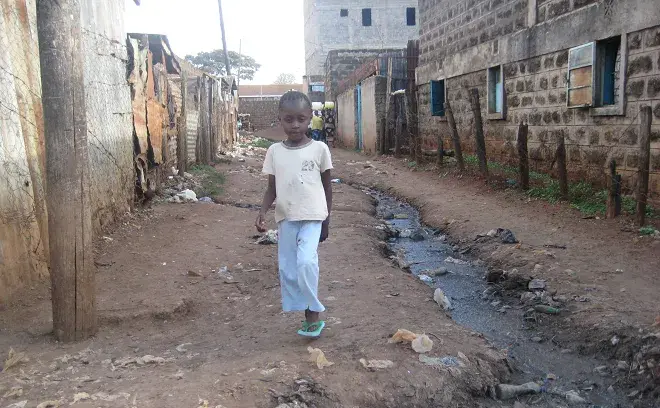Susan Wangiku, Kenya
Intestinal parasites have robbed five year-old Susan Wangiku of her appetite. They are stripping iron from her guts. When she eats, her stomach hurts afterward. Her eyes are swollen, yellow, and itchy, a sign of infection.
Susan plays, unattended, amid the trash and waste of Kangaware slum in Kenya. The slum is next-door to Lavington, a rich estate with the most prestigious schools in Nairobi.
She goes down paths strewn with garbage to her 10-square meter house, where she lives with her family of five. There is no toilet here – the family must share a latrine with 20 families. The slum has no running water.
A neighbor recently told Susan’s mother, Margaret, that the children need to be de-wormed. But Margaret’s focus is getting food on the table. She says Susan must just have a cold. In any case, there is little chance she will take her to the hospital: “There are no public hospitals close by,” says Margaret. “If you want to be attended you must go to the hospital very early. Sometimes, by 1pm, the doctor has not even checked you.”
Susan’s father is the family breadwinner, working as a public transport conductor for sixteen hours every day of the week, for 200KSH (2€) a day. He and Margaret cannot afford to give the children lunch.
Susan plays with two cousins who also live in the slum. Both boys have large, distended stomachs. They have had worms for a long time. Their mother, Damaris, knows that – but says she does not believe that the worms have any negative effect on her children. She lost twins, aged two, in 2006. She never discovered what illness claimed their lives.
In 2005, eighteen lobby groups launched a campaign to convince aid donors to look at all of the problems of developing African countries like Kenya through the prism of climate change. They said that each and every project should pass the test: “Are you increasing or decreasing people's vulnerability to the climate?”
Surely the best test of aid is how its impact measures up to its cost. De-worming 53 million suffering preschool-aged children like Susan would cost just fifty cents a child, for a total outlay of $26.5 million. One 50 cent investment would mean that when Susan reaches school next year, she will be able to concentrate on lessons. When her parents give her the one daily meal that they can afford, she – and not the worms – will benefit from the nutrition.
In economic terms – calculating the value of longer, healthier, more productive lives – researchers say that the benefits of a de-worming investment are at least six-times more than the cost.
In contrast, spending thousands of times more money on carbon emission reductions would reduce temperatures by only a tiny amount in 100 years. It is so ineffective that even when researchers add up all the environmental and human benefits from lower temperatures, they are still only a fraction of the cost.
How can we best help Susan? By investing in de-worming interventions. And that is just the beginning. As Susan’s mother says, “We need everything. Do you not see the conditions we live under?” But de-worming children is undoubtedly an excellent place to start.
The goal of aid should always be to achieve the most good possible. That is the test which investment decisions should pass. Spending billions of dollars on carbon regulations will help Susan a tiny amount in many years’ time. In contrast, a dramatically smaller investment today in de-worming could open up new opportunities that would, indeed, transform her life.
Researcher: Joana Socías


